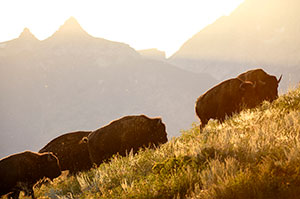
Wildlife is a key attraction for visitors to Grand Teton and Yellowstone national parks, but some animals range widely beyond park boundaries and bring management expenses to surrounding areas, according to a new paper from research scientists, including the University of Wyoming.
According to the research, while local governments and communities near national parks compensate ranchers for livestock depredation by large carnivores, build highway crossings and wildlife-friendly fences for migrating wildlife, and secure conservation easements on private land, the more than 4 million people who visit the two parks annually present a potential revenue source for conservation. A recently published paper by scientists from UW, the University of California-Berkeley, Arizona State University and the University of British Columbia explores potential mechanisms for park visitors to share wildlife management costs with local governments and landowners, with Grand Teton and Yellowstone national parks as a case study.
Arthur Middleton, who earned his doctoral degree in ecology from UW, was the lead author of the paper, titled “Harnessing visitors’ enthusiasm for national parks to fund cooperative large-landscape conservation.” Middleton is now an assistant professor in the Department of Environmental Science, Policy and Management at the University of California-Berkeley and leads a field research program at the Buffalo Bill Center of the West in Cody.
“The greater Yellowstone is where the concept of ‘ecosystem management’ was first introduced, yet it’s been a largely unfunded mandate for many decades,” Middleton says. “The time is overdue for asking park visitors to chip in.”
The paper recently was published in the journal Conservation Science and Practice and is available online at https://doi.org/10.1111/csp2.335. A summary is available on the UW Haub School of Environment and Natural Resources website at www.uwyo.edu/haub/research/research-briefs.html.
“As proposals for generating conservation funding from national park visitors have come forward, we saw a need to take a closer look at how this might work legally and economically,” says Temple Stoellinger, an assistant professor of law and environment and natural resources at UW, and a co-author of the study. “Our team of researchers wanted to provide some background assessment to support putting these ideas into action.”
The researchers investigated two ways that states could tap national park visitors to help pay for wildlife conservation beyond park boundaries:
-- Partner with the national parks to charge a “conservation fee” to visitors at the gate, which would be returned to the state and earmarked for nearby wildlife conservation. The Wyoming Legislature passed a bipartisan resolution supporting this idea in 2018 that was introduced by Rep. Albert Sommers (R-Sublette County).
-- Increase state sales tax or a lodging fee that would be applied only within the national parks, and direct revenue to protecting and mitigating impacts to wildlife and the public outside of the park boundaries.
The overall goal of any such effort would be to shift some of the costs for wildlife conservation from states and surrounding communities onto the visitors who enjoy seeing wild animals in Grand Teton and Yellowstone national parks. An earlier study found park visitors are willing to compensate ranchers for wolf predation on livestock in order to protect the wolves.
“I think the next step is for interested groups and policymakers in the three states -- Wyoming, Montana and Idaho -- to get together and really think about this,” Sommers says. “We are in a time of fiscal crisis, so how can we be creative and find some new funding to preserve our wildlife and mitigate wildlife conflicts?”
The concept of a conservation fee also has met with some interest in Montana, where legislators are introducing a resolution closely modeled after the one Wyoming passed.
“It’s important that Montana, Wyoming and Idaho come together behind this initiative and work together with Yellowstone and Glacier national parks so states and federal agencies are partnering up. Many, many wildlife species don’t recognize park boundaries but need habitat in and outside of the parks to survive and thrive,” says Montana state Rep. Tom France (D-Missoula). “I thought the resolution Albert Sommers introduced in 2018 was a really good idea. The fact that the Wyoming Legislature passed it overwhelmingly lent his idea a lot of credibility.”
Other countries have similar mechanisms. For example, tiger reserves in India funnel visitor fee revenues to human-wildlife conflict mitigation efforts, and park entry fees in Uganda support local communities. Though this approach has not been applied in the United States, “the concept of using park visitation to fund large‐landscape conservation … appears promising for systems with significant cross‐boundary conservation needs and high visitation rates,” the researchers wrote.
For Yellowstone National Park, the researchers estimated that a conservation‐fee approach -- charging $1 to $10 per vehicle -- could raise more than $500,000 to $13 million annually. Tax‐based approaches could raise from nearly a million dollars for a $1-a-night lodging fee to $22 million for a 2 percent annual sales tax increase. Varying combinations of taxes and fees would have potential to raise even more funds as well as leverage additional state, local or private conservation money.
The researchers found that current federal law might not permit the use of park entrance fees beyond park boundaries and suggest one path forward would be new federal law creating a pilot program limited to the greater Yellowstone ecosystem over a fixed time. While an increase in a state-imposed sales or lodging tax would face fewer legal hurdles, the researchers recommend with this approach establishing a board of stakeholder representatives to ensure that funds are directed to meaningful wildlife conservation actions.
The researchers suggest surveying the public and key stakeholders along with creating a pilot proposal as important next steps.
For more information, call Emilene Ostlind, UW’s Haub School of Environment and Natural Resources communications coordinator, at (307) 314-9505 or email emilene@uwyo.edu.

